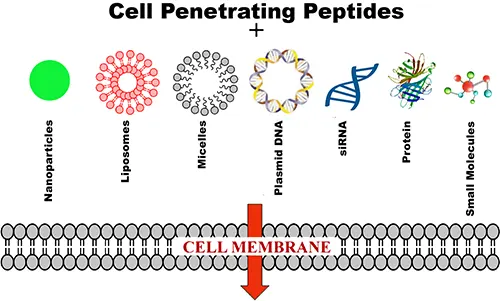Cell Penetrating Peptides
Cell-penetrating peptides (CPPs) have emerged as revolutionary tools in biomedical research and therapy, particularly for their ability to facilitate the transport of cargo molecules across cell membranes. Their application spans drug delivery to vaccine development, providing a non-invasive and efficient method for transporting therapeutic molecules into cells.
CPPs, consisting of short sequences of amino acids, are known for their amphipathic and/or cationic nature, which enables them to interact with cellular membranes effectively. These peptides can transport a wide range of bioactive substances, including proteins, DNA, RNA, and nanoparticles, into cells, thus opening up new avenues for therapeutic interventions. The ability of CPPs to deliver cargo molecules into cells without disrupting the membrane integrity is a critical feature that distinguishes them from other delivery vectors.
In the realm of nanotherapeutics, CPPs have shown great potential in enhancing the delivery of therapeutic molecules into cells, thereby overcoming the challenges posed by the physicochemical properties of the delivery vehicles and the biological barriers. Their applications have been extensively explored in cancer therapy, where they improve the intracellular delivery of nanocarriers, facilitating tumor imaging and targeted drug delivery. Moreover, CPPs are being used to address other medical challenges, such as evaluating atherosclerotic plaques and HIV therapy, demonstrating their versatility in medical applications.
CPPs also play a crucial role in vaccine development, where they are used to enhance the stability and delivery of antigens to immune cells. By fusing antigens with CPPs, researchers have been able to improve the presentation of antigens by antigen-presenting cells (APCs), leading to the induction of both humoral and cellular immunity. This strategy has been applied to the development of vaccines against various infectious diseases, showing promise in improving the effectiveness of vaccines.
The therapeutic applications of CPPs extend beyond drug delivery and vaccine development. They have been explored in diagnosing and treating a range of human diseases, from cancer to infectious diseases, demonstrating their potential in clinical applications. The ability of CPPs to deliver mRNA and other genetic materials into cells has opened new possibilities for gene therapy and the development of mRNA vaccines.
Despite the promising applications of CPPs, challenges remain in understanding their cellular entry and internalization mechanisms. This knowledge gap limits their more comprehensive clinical application. However, ongoing research continues to unravel the complexities of CPP-mediated delivery, with studies employing advanced techniques to quantify and understand the intracellular trafficking of CPPs and their cargo.
In summary, CPPs represent a versatile and powerful tool in the advancement of therapeutic strategies, offering a non-invasive, efficient, and potentially transformative approach to drug delivery and vaccine development. Their ability to cross biological barriers and deliver a wide range of bioactive molecules into cells holds significant promise for the future of medicine.

